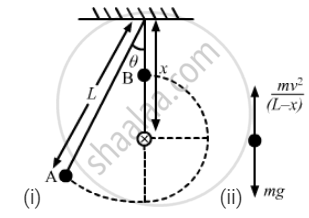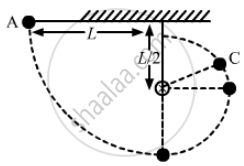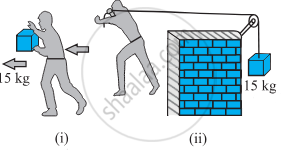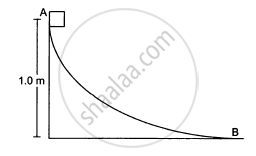Advertisements
Advertisements
Question
A simple pendulum of length L with a bob of mass m is deflected from its rest position by an angle θ and released (following figure). The string hits a peg which is fixed at a distance x below the point of suspension and the bob starts going in a circle centred at the peg. (a) Assuming that initially the bob has a height less than the peg, show that the maximum height reached by the bob equals its initial height. (b) If the pendulum is released with \[\theta = 90^\circ \text{ and x = L}/2\] , find the maximum height reached by the bob above its lowest position before the string becomes slack. (c) Find the minimum value of x/L for which the bob goes in a complete circle about the peg when the pendulum is released from \[\theta = 90^\circ \]

Solution

(a) When the bob has an initial height less than the distance of the peg from the suspension point and the bob is released from rest (Fig.(i)),
let body travels from A to B then by the principle of conservation of energy (total energy should always be conserved)
Total energy at A = Total energy at B
\[\text{ i . e }. \left( \text{ K . E .} \right)_A + \left( P . E . \right)_A = \left( K . E . \right)_B + \left( P . E . \right)_B \]
\[ \Rightarrow \left( P . E . \right)_A = \left( P . E . \right)_B \]
\[\text{ because }\left( K . E . \right)_A = \left( K . E . \right)_B = 0\]
So, the maximum height reached by the bob is equal to the initial height of the bob.
(b) When the pendulum is released with θ \[= 90^\circ \text{ and x }= \frac{L}{2},\]
Let the string become slack at point C, so the particle will start making a projectile motion.

Applying the law of conservation of emergy
\[ \Rightarrow V_c^2 = gL \left( 1 - \cos \alpha \right) . . . (i)\]
From equations (i) and (ii),
\[ \Rightarrow 1 - \cos \alpha = \frac{1}{2} \cos \alpha\]
\[ \Rightarrow \frac{3}{2} \cos \alpha = 1\]
\[ \Rightarrow \cos \alpha = \left( \frac{2}{3} \right) . . . (\text{iii})\]
\[ = \frac{L}{2} + \frac{L}{2} \times \frac{2}{3}\]
\[ = L \left( \frac{1}{2} + \frac{1}{3} \right)\]
\[\text{ So, BF }= \left( \frac{5L}{6} \right)\]
Again, applying energy conservation principle between A and C
\[\left( \frac{1}{2} \right) \text{m}\nu_c^2 - 0 = \text{mg}\left( OC \right)\]
\[ \Rightarrow \left( \frac{1}{2} \right) \text{m}\nu_c^2 = \text{mg}\left\{ L - 2 \left( \text{L - x} \right) \right\}\]
\[ = mg \left( 2\text{x - L} \right)\]
\[ \Rightarrow \nu_c^2 = 2g \left( 2\text{x - L} \right) . . . (\text{ii})\]
From equations (i) and (ii),
\[g \left( L - \text{ x }\right) = 2g \left( 2\text{x - L} \right)\]
\[ \Rightarrow\text{ L - x = 4x - 2L}\]
\[ \Rightarrow 5x = 3L\]
\[ \therefore \frac{x}{L} = \frac{3}{5} = 0 . 6\]
\[\text{ So, the minimum value of } \left( \frac{x}{L} \right) \text{ shoule be }0 . 6 .\]
APPEARS IN
RELATED QUESTIONS
In Figure (i) the man walks 2 m carrying a mass of 15 kg on his hands. In Figure (ii), he walks the same distance pulling the rope behind him. The rope goes over a pulley, and a mass of 15 kg hangs at its other end. In which case is the work done greater?

Is work-energy theorem valid in non-inertial frames?
A ball is given a speed v on a rough horizontal surface. The ball travels through a distance l on the surface and stops. What is the work done by the kinetic friction?
Consider the situation of the previous question from a frame moving with a speed v0 parallel to the initial velocity of the block. (a) What are the initial and final kinetic energies? (b) What is the work done by the kinetic friction?
The US athlete Florence Griffith-Joyner won the 100 m sprint gold medal at Seoul Olympics in 1988, setting a new Olympic record of 10⋅54 s. Assume that she achieved her maximum speed in a very short time and then ran the race with that speed till she crossed the line. Take her mass to be 50 kg. Calculate the kinetic energy of Griffith-Joyner at her full speed.
A water pump lifts water from 10 m below the ground. Water is pumped at a rate of 30 kg/minute with negligible velocity. Calculate the minimum horsepower that the engine should have to do this.
In a factory, 2000 kg of metal needs to be lifted by an engine through a distance of 12 m in 1 minute. Find the minimum horsepower of the engine to be used.
A scooter company gives the following specifications about its product:
Weight of the scooter − 95 kg
Maximum speed − 60 km/h
Maximum engine power − 3⋅5 hp
Pick up time to get the maximum speed − 5 s
Check the validity of these specifications.
A block of mass 30 kg is being brought down by a chain. If the block acquires a speed of 40 cm/s in dropping down 2 m, find the work done by the chain during the process.
A block of mass 100 g is moved with a speed of 5⋅0 m/s at the highest point in a closed circular tube of radius 10 cm kept in a vertical plane. The cross-section of the tube is such that the block just fits in it. The block makes several oscillations inside the tube and finally stops at the lowest point. Find the work done by the tube on the block during the process.
A block weighing 10 N travels down a smooth curved track AB joined to a rough horizontal surface (In the following figure). The rough surface has a friction coefficient of 0⋅20 with the block. If the block starts slipping on the track from a point 1⋅0 m above the horizontal surface, how far will it move on the rough surface?

A block of mass 5 kg is suspended from the end of a vertical spring which is stretched by 10 cm under the load of the block. The block is given a sharp impulse from below, so that it acquires an upward speed of 2 m/s. How high will it rise? Take g = 10 m/s2.
A particle of mass m is kept on the top of a smooth sphere of radius R. It is given a sharp impulse which imparts it a horizontal speed ν. (a) Find the normal force between the sphere and the particle just after the impulse. (b) What should be the minimum value of ν for which the particle does not slip on the sphere? (c) Assuming the velocity ν to be half the minimum calculated in part, (b) find the angle made by the radius through the particle with the vertical when it leaves the sphere.
A chain of length l and mass m lies on the surface of a smooth sphere of radius R > l with one end tied to the top of the sphere. Find the tangential acceleration \[\frac{d\nu}{dt}\] of the chain when the chain starts sliding down.
Two bodies of unequal mass are moving in the same direction with equal kinetic energy. The two bodies are brought to rest by applying retarding force of same magnitude. How would the distance moved by them before coming to rest compare?
A rocket accelerates straight up by ejecting gas downwards. In a small time interval ∆t, it ejects a gas of mass ∆m at a relative speed u. Calculate KE of the entire system at t + ∆t and t and show that the device that ejects gas does work = `(1/2)∆m u^2` in this time interval (neglect gravity).
